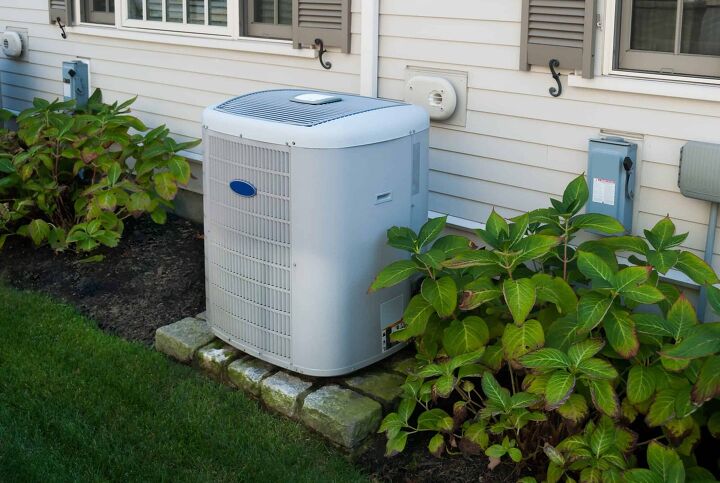Is Your AC Liquid Line Very Hot? (Possible Causes & Fixes)

The liquid line on your air conditioner is a big part of its proper operation. It is common for the line to become hot, and it is often due to it being dirty or underpowered. Follow along as we explore how you can cool down the liquid line on your AC.
If you are considering upgrading your heating or air conditioning system, get a quote from local contractors in your area here.
Is your AC not performing correctly? Problems with air conditioning can be extremely frustrating, especially when it’s hot outside. We look at the reasons that an AC liquid line can get hot, and what that means for your system.
AC liquid lines can become very hot if there is a problem with the condenser, such as it being dirty, or not working properly. Clean your condenser, and if the problem continues you may need to replace it or troubleshoot further.
Working on air conditioners is something that takes a little bit of know-how. You really have to inspect your unit and get a hands-on approach to troubleshooting.
Some lines should be cold to the touch, some warm. If your liquid line is very hot, instead of warm, then there could be a problem. We’re going to show you a few ways to troubleshoot your AC, to find out what might be causing the problem.
What is the Purpose of a Liquid Line on an AC?
If you are anything like me, you want to know how things work. I have spent a lot of time looking at AC specs online, however, the best way to troubleshoot is to use your hands. Get a feel for what lines are cold, and what lines are hot.
An air conditioner has multiple stages, where a refrigerant evaporates and creates a vapor. The AC uses heat to pull moisture out of the air, then condenses that moisture, and turns it into a liquid gas.
The vapor heats and cools off multiple times. The liquid line delivers the refrigerant to an expansion valve that depressurizes the liquid and sends it back to the evaporator. Then the cycle repeats itself.
Which Line is the Liquid Line on an AC?
There is more than one line on an AC, so which one is the liquid line? An AC unit usually has two lines. One line holds cool gas and is known as the suction line or vapor line. The other line carries a warm liquid and is known as the liquid line.
The suction line carries a cool gas to the compressor. This line should be cold to the touch and is insulated. Even though the line is insulated, it should still feel cold when you touch it. The suction line should be free of any restriction or leaks.
The liquid line is a plain copper line. Both the lines are copper, but the suction line has insulation over it. The liquid line should be warm to the touch. If your liquid line is very hot, there is a chance something isn’t working correctly.
How to Troubleshoot Your AC
When troubleshooting anything, you should always start with the simplest or most common problem first. The most common problem that causes an AC line to be very hot, is a condenser that is dirty, or not working properly.
You will want to start by cleaning your condenser. This can be a bit of a job, but if it fixes your AC, it’s well worth the time. If this does not fix your problem, then you will need to troubleshoot further.
Use your hands to feel the lines. Check that the suction line is cool to the touch. If you have to, get into the insulation a little, to feel the actual copper line. If it is not cool, then you may need to recharge your refrigerant. The worst-case scenario is a compressor is out, or one of the lines has a leak.
In the case of the later, the AC may need to be replaced completely or worked on by an AC repair shop.
How to Clean an AC Condenser
The ac condenser uses coils, to condense vapors into a gas form. These coils can get dirty over time, with dust, spiderwebs, and junk from outside. The very first thing you can do is spray your condenser with water.
It does not hurt the condenser to spray it with water, it can help loosen dirt. It is also good to spray the condenser now and then, just to keep dirt from collecting in the coils. If the water does not get it clean, and your liquid line is still hot, then you may have to use a cleaner and other methods.
Start by unplugging your unit, then take the AC case/cover off of the unit. The coils are fine and can collect all kinds of debris. You will need to rinse away what you can with water. Then use a coil comb to brush any large pieces out. You need to remove all large clumps of dirt or debris.
You may also need to straighten the coil fins. The coil fins can get pressed together, which can cause the condenser to not work properly. You do this with a coil fin brush. It evens out the coils and helps you get in between to clean.
After you have your condenser cleaned, and the coil fins looking good, put the cover back on your AC. Then plug it in, and let it sit for 24 hours.
Subcooling in the Condenser
If the condenser is not the issue, you will need to check the subcooling levels in the condenser. This is to make sure all the liquids are the temperatures they are supposed to be, and that they are at the right levels.
Checking these levels will also help you know if your refrigerant is charged enough. You may need to recharge your unit. The less refrigerant charge you have, the less the levels in the sub-cooling will be.
The subcooling, or amount of refrigerant charge, could be the reason your liquid line is hot. You will have to have some knowledge of AC repair to do this. If you do not have the right tools or experience, you may need to consider calling a repair shop.
Undercharge and Overcharge
One of the elements that make the AC work, is the refrigerant charge. The AC uses a refrigerant, to pull the heat out of the air and to collect the moisture. If your AC is undercharged, or overcharged, it could cause the liquid line to overheat.
If your AC is undercharged, you will need to have it recharged. This adds more refrigerant to your system. If your system is overcharged by more than 10 percent, the liquid may enter the suction line. Either way, you will need a professional to recharge, or reduce, the amount of refrigerant.
Not having it done properly can be dangerous to your health. The EPA requires that licensed professionals do this kind of maintenance.
Related Guides
UpgradedHome participates in affiliate programs. When you purchase through our links, we may earn a commission.

I'm a writer that is passionate about home improvements, remodeling, and renovating. I enjoy learning new skills and techniques and sharing them with others.
More by Chad Kilpatrick











![10 Best Electric Pressure Washers – [2022 Reviews & Guide]](https://cdn-fastly.upgradedhome.com/media/2023/07/31/9070600/10-best-electric-pressure-washers-2022-reviews-guide.jpg?size=350x220)
![How Much Weight Can a 4×4 Support Horizontally? [It Depends!]](https://cdn-fastly.upgradedhome.com/media/2023/07/31/9070333/how-much-weight-can-a-44-support-horizontally-it-depends.jpg?size=350x220)














